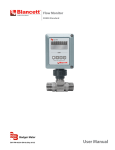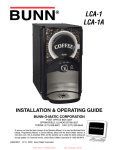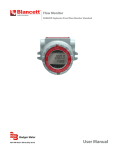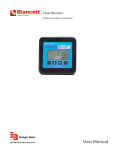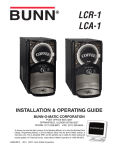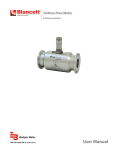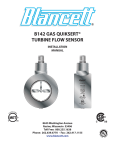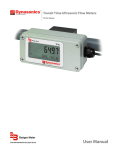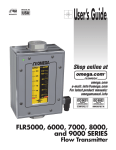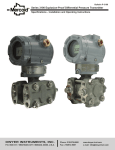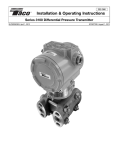Download User Manual - Badger Meter, Inc.
Transcript
Flow Monitor B2800 Advanced DSY-PM-00286-EN-02 (May 2015) User Manual Flow Monitor, B2800 Advanced CONTENTS Scope of This Manual . . . . . . . . . . . . . . . . . . . . . . . . . . . . . . . . . . . . . . . . . . . . . . . . . . . . . . . . . . . . . . . . . . . .3 Unpacking and Inspection . . . . . . . . . . . . . . . . . . . . . . . . . . . . . . . . . . . . . . . . . . . . . . . . . . . . . . . . . . . . . . . .3 Safety . . . . . . . . . . . . . . . . . . . . . . . . . . . . . . . . . . . . . . . . . . . . . . . . . . . . . . . . . . . . . . . . . . . . . . . . . . . . . 3 Terminology and Symbols . . . . . . . . . . . . . . . . . . . . . . . . . . . . . . . . . . . . . . . . . . . . . . . . . . . . . . . . . . . . . .3 Considerations . . . . . . . . . . . . . . . . . . . . . . . . . . . . . . . . . . . . . . . . . . . . . . . . . . . . . . . . . . . . . . . . . . . . .3 Introduction . . . . . . . . . . . . . . . . . . . . . . . . . . . . . . . . . . . . . . . . . . . . . . . . . . . . . . . . . . . . . . . . . . . . . . . . . 4 Operating the Monitor . . . . . . . . . . . . . . . . . . . . . . . . . . . . . . . . . . . . . . . . . . . . . . . . . . . . . . . . . . . . . . . . . . .5 Buttons . . . . . . . . . . . . . . . . . . . . . . . . . . . . . . . . . . . . . . . . . . . . . . . . . . . . . . . . . . . . . . . . . . . . . . . . . 5 Modes . . . . . . . . . . . . . . . . . . . . . . . . . . . . . . . . . . . . . . . . . . . . . . . . . . . . . . . . . . . . . . . . . . . . . . . . . . 5 Programming . . . . . . . . . . . . . . . . . . . . . . . . . . . . . . . . . . . . . . . . . . . . . . . . . . . . . . . . . . . . . . . . . . . . . . . . 6 Programming Mode . . . . . . . . . . . . . . . . . . . . . . . . . . . . . . . . . . . . . . . . . . . . . . . . . . . . . . . . . . . . . . . . . 6 Return to Run Mode . . . . . . . . . . . . . . . . . . . . . . . . . . . . . . . . . . . . . . . . . . . . . . . . . . . . . . . . . . . . . . . . . 9 Run Mode . . . . . . . . . . . . . . . . . . . . . . . . . . . . . . . . . . . . . . . . . . . . . . . . . . . . . . . . . . . . . . . . . . . . . . . .9 Additonal Scaling Parameters . . . . . . . . . . . . . . . . . . . . . . . . . . . . . . . . . . . . . . . . . . . . . . . . . . . . . . . . . . . . . .9 Flow 4 mA Setting . . . . . . . . . . . . . . . . . . . . . . . . . . . . . . . . . . . . . . . . . . . . . . . . . . . . . . . . . . . . . . . . . . 10 Flow 20 mA Setting . . . . . . . . . . . . . . . . . . . . . . . . . . . . . . . . . . . . . . . . . . . . . . . . . . . . . . . . . . . . . . . . . 10 4…20 mA Calibration . . . . . . . . . . . . . . . . . . . . . . . . . . . . . . . . . . . . . . . . . . . . . . . . . . . . . . . . . . . . . . . 10 4…20 mA Test . . . . . . . . . . . . . . . . . . . . . . . . . . . . . . . . . . . . . . . . . . . . . . . . . . . . . . . . . . . . . . . . . . . . 10 Battery Replacement . . . . . . . . . . . . . . . . . . . . . . . . . . . . . . . . . . . . . . . . . . . . . . . . . . . . . . . . . . . . . . . . . . . 10 Additional Input Options . . . . . . . . . . . . . . . . . . . . . . . . . . . . . . . . . . . . . . . . . . . . . . . . . . . . . . . . . . . . . . . . 11 Additional Scaling Information . . . . . . . . . . . . . . . . . . . . . . . . . . . . . . . . . . . . . . . . . . . . . . . . . . . . . . . . . . . . 12 Pulse Output Signals for Linear Processes . . . . . . . . . . . . . . . . . . . . . . . . . . . . . . . . . . . . . . . . . . . . . . . . . . . 12 Pulse Output Signals for Non-linear Processes . . . . . . . . . . . . . . . . . . . . . . . . . . . . . . . . . . . . . . . . . . . . . . . . 13 Default K-factor Values . . . . . . . . . . . . . . . . . . . . . . . . . . . . . . . . . . . . . . . . . . . . . . . . . . . . . . . . . . . . . . . . . . 13 Troubleshooting Guide . . . . . . . . . . . . . . . . . . . . . . . . . . . . . . . . . . . . . . . . . . . . . . . . . . . . . . . . . . . . . . . . . 14 Part Number Information . . . . . . . . . . . . . . . . . . . . . . . . . . . . . . . . . . . . . . . . . . . . . . . . . . . . . . . . . . . . . . . . 14 Specifications . . . . . . . . . . . . . . . . . . . . . . . . . . . . . . . . . . . . . . . . . . . . . . . . . . . . . . . . . . . . . . . . . . . . . . . 15 Mounting Options and Dimensions . . . . . . . . . . . . . . . . . . . . . . . . . . . . . . . . . . . . . . . . . . . . . . . . . . . . . . . . . 16 Meter Mount . . . . . . . . . . . . . . . . . . . . . . . . . . . . . . . . . . . . . . . . . . . . . . . . . . . . . . . . . . . . . . . . . . . . . 16 Remote Mount . . . . . . . . . . . . . . . . . . . . . . . . . . . . . . . . . . . . . . . . . . . . . . . . . . . . . . . . . . . . . . . . . . . . 16 Swivel Mount . . . . . . . . . . . . . . . . . . . . . . . . . . . . . . . . . . . . . . . . . . . . . . . . . . . . . . . . . . . . . . . . . . . . . 17 Replacement Parts . . . . . . . . . . . . . . . . . . . . . . . . . . . . . . . . . . . . . . . . . . . . . . . . . . . . . . . . . . . . . . . . . . . . 18 Installation Drawing . . . . . . . . . . . . . . . . . . . . . . . . . . . . . . . . . . . . . . . . . . . . . . . . . . . . . . . . . . . . . . . . . . . 19 Page ii May 2015 Scope of This Manual SCOPE OF THIS MANUAL This manual is intended to help you get the B2800 flow monitor up and running quickly. IIMPORTAN Read this manual carefully before attempting any installation or operation. Keep the manual accessible for future reference. UNPACKING AND INSPECTION Upon opening the shipping container, visually inspect the product and applicable accessories for any physical damage such as scratches, loose or broken parts, or any other sign of damage that may have occurred during shipment. NNOTE: If damage is found, request an inspection by the carrier’s agent within 48 hours of delivery and file a claim with the carrier. A claim for equipment damage in transit is the sole responsibility of the purchaser. SAFETY Terminology and Symbols Indicates a hazardous situation, which, if not avoided, is estimated to be capable of causing death or serious personal injury. Indicates a hazardous situation, which, if not avoided, could result in severe personal injury or death. Indicates a hazardous situation, which, if not avoided, is estimated to be capable of causing minor or moderate personal injury or damage to property. Considerations The installation of the B2800 monitor must comply with all applicable federal, state, and local rules, regulations, and codes. EXPLOSION HAZARD - SUBSTITUTION OF COMPONENTS MAY IMPAIR SUITABILITY FOR CLASS I, DIVISION 2. AVERTISSMENT RISQUE D’EXPLOSION - LA SUBSTITUTION DE COMPOSANTS PEUT RENDRE CEMATÉRIEL INACCCEPTABLE POUR LES EMPLACEMENTS DE CLASSE I, DIVISION 2. DO NOT CONNECT OR DISCONNECT EITHER POWER OR OUTPUTS UNLESS THE AREA IS KNOWN TO BE NONHAZARDOUS. AVERTISSMENT RISQUE D’EXPLOSION. NE PAS DÉBRANCHER TANT QUE LE CIRCUIT EST SOUSTENSION, À MOINS QU’LL NE S’AGISSE D’UN EMPLACEMENT NON DANGEREUX. IIMPORTAN Not following instructions properly may impair safety of equipment and/or personnel. May 2015 DSY-PM-00286-EN-02 Page 3 Introduction INTRODUCTION The B2800 flow monitor is a state-of-the-art digital signal processing flow monitor, designed to provide exceptional flexibility at a very affordable price. Though designed for use with Blancett flow meters, this display can be used with almost any flow meter producing a low amplitude AC output or contact closure signal. This flow monitor is capable of accepting a low level frequency input for calculating flow rate and total. These calculations can then be displayed in the specified units of measurement. All B2800 flow monitors are pre-programmed at the factory, if ordered with a Blancett flow meter. If required, however, the monitor can easily be reconfigured in the field. The monitor’s large 8-digit by 0.75 in. (19.05 mm) numeric liquid crystal display makes extended range viewing practical. The second 8-digit by 0.38 in. (9.65 mm) alphanumeric display provides for selectable units viewing in RUN mode and prompts for variables in program mode. You can display rate or total, or alternate between rate and total. Page 4 DSY-PM-00286-EN-02 May 2015 Operating the Monitor OPERATING THE MONITOR Rate / Total Display And Programming Choices Mode Indicator RUN PROGRAM RELAY1 RELAY2 Units Display And Programming Choices Programming Keys Figure 1: B2800 flow monitor Buttons MENU Enters and exits PROGRAM mode UP Scrolls forward through the parameter options, increments numeric variables and scrolls backward through parameters RIGHT Scrolls backward through the parameter options, moves the active digit to the right and scrolls forward through parameters ENTER Saves programming information, advances to the next programming parameter, and used in the reset process Modes RUN Normal operating mode PROGRAM Used to program parameters in the display If your monitor was ordered with a Blancett flow meter, the two components ship from the factory calibrated as a set. If the monitor is a replacement, the turbine’s K-factor has changed or the monitor is being used with some other pulse generating device, the monitor must be programmed. May 2015 DSY-PM-00286-EN-02 Page 5 Programming PROGRAMMING Each turbine flow meter is shipped with either a K-factor value or frequency data. If frequency data is provided, the data must be converted to a K-factor before programming the monitor. K-factor information, when supplied, can usually be found on the neck of the flow meter or stamped on the flow meter body. The K-factor represents the number of pulses per unit of volume. The K-factor will be needed to program the monitor readout. Programming Mode See Note Note: Only available when either KGS or LBS are Selected x x Figure 2: Advanced programming menu Enter Programming Mode Press MENU to enter the programming mode. The mode indicator changes from RUN to PROGRAM. NNOTE: If any input value exceeds the meter’s capabilities for that particular parameter, the LIMIT indicator flashes, indicating an invalid entry. Press ENTER to return to the parameter’s entry screen to reenter the value. Select Meter Size At the METER prompt, press ENTER. The current meter size flashes. If the current setting is correct, press ENTER to advance to the next parameter. To change the current setting, press UP or RIGHT to scroll to the bore size of your meter. Press ENTER to save and advance to the DISPLAY parameter. NNOTE: The meter connection size and the bore size are different. For example, many of the one inch NPT turbines have bore sizes that range from 3/8…1 in. (9.53…25.4 mm). Use the correct bore size so the meter will report correct flows and totals. Select Display Function The monitor can display RATE or TOTAL or alternate between BOTH rate and total. At the DISPLAY prompt, press ENTER. The monitor shows the current display mode. To change to an alternate display mode, press UP or RIGHT to scroll to the correct display mode. Press ENTER to save and advance to the RATE UNT parameter. Select Units of Measure At the RATE UNT prompt, press ENTER. The monitor shows the current rate unit. If the current selection is correct, press ENTER to advance to the next parameter. To change to an alternate unit, press UP or RIGHT to scroll to the correct rate unit. Press ENTER to save and advance to the RATE INT parameter. Page 6 DSY-PM-00286-EN-02 May 2015 Programming Select Rate (Time) Interval At the RATE INT prompt, press ENTER. The monitor shows the current time interval. If the current selection is correct, press ENTER to advance to the next parameter. To change to an alternate time interval, press UP or RIGHT to scroll to the correct time interval. Press ENTER to save and advance to the TOTL UNT parameter. NNOTE: If flow rate is the only measurement of interest, press RIGHT to advance to the KFAC UNT to complete the programming process. Select Units of Measure At the TOTAL UNT prompt, press ENTER. The monitor shows the current total units. If the current selection is correct, press ENTER to advance to the next parameter. To change to an alternate unit, press UP or RIGHT to scroll to the correct totalization unit. Press ENTER to save and advance to the TOTL MUL parameter. NNOTE: This unit of measure does not have to reflect the rate unit you have previously chosen. Example: Rate Units = Gallons, Total Units = Barrels Select Total's Display Multiplier This parameter displays the accumulated flow total in multiples of 10. For example, if the optimum totalization unit is 1000 gallons, the unit total display increments by one digit for every 1000 gallons monitored. In RUN mode, at 1000 gallons the total monitor reads 1, at 3000 gallons, the total display reads 3. This feature eliminates having to look at a total, count the digits, and mentally insert commas for each 1000 multiple. At the TOTL MUL prompt, press ENTER. The monitor shows the current total multiplier. If the current selection is correct, press ENTER to advance to the next parameter. To change to an alternate multiplier, press UP or RIGHT to scroll to the correct multiplier unit. Press ENTER to save and advance to the KFAC UNT parameter. NNOTE: If pounds or kilograms were chosen as the RATE UNT or TOTL UNT, the monitor advances to the SP GRAV parameter. Specific Gravity At the SP GRAV parameter, press ENTER. The first digit of the current specific gravity flashes. If the current setting is correct, press ENTER to advance to the next parameter. To change the current setting, press RIGHT to move to the correct digit. Press UP to increment the digit. Repeat for all digits. Press ENTER to save and advance to the KFAC UNT parameter. Enter Meter's K-Factor Unit NNOTE: The K-factor supplied with the meter, or calculated from calibration data, is needed to complete this step. At the KFAC UNT prompt, press ENTER. The display shows the current K-factor unit. If the current selection is correct, press ENTER to advance to the next parameter. To change the K-factor, press UP or RIGHT to scroll to the correct K-factor. Press ENTER to save and advance to the SCALE F parameter. NNOTE: For meters calibrated in gallons, use PUL/GAL; for meters calibrated in cubic meters, use PUL/M3 or any other unit option. Scale Factor The scale factor is used to force a global change to all variables. For example, under operating conditions the display is reading a consistent three percent below the expected values at all flow rates. Rather than changing all parameters individually, the scale factor is used to compensate for the three percent offset. Set the scale factor to 1.03 to correct the readings. The range of scale factors is 0.5…1.5. The default scale factor is 1.0. At the SCALE F prompt, press ENTER. The first digit of the current scale factor flashes. If the current selection is correct, press ENTER to advance to the next parameter. To change to an alternate scale factor, press UP to increment the display digit until it matches the first digit of the new scale factor. Press RIGHT to advance to the next digit. Repeat for all digits. Press ENTER to save and advance to the METERTYP parameter. May 2015 DSY-PM-00286-EN-02 Page 7 Programming Meter Type At the METERTYP prompt, press ENTER. The current meter type displays. If the current selection is correct, press ENTER to advance to the next parameter. To change the type, press UP or RIGHT. Press ENTER to save and advance to the next parameter. If GAS is selected, the operating pressure (psig) and operating temperature (° F) must be entered. If LIQUID is selected, the monitor advances to the DAMPING parameter. NNOTE: The 4…20 mA zero and span values are not factory set. Operating Pressure At the OP PRES prompt, press ENTER. The first digit of the current setting flashes. If the current setting is correct, press ENTER to advance to the next paramter. To change the current setting, press RIGHT to move to the correct digit. Press UP to increment the digit until it matches the new operating pressure. Repeat for all digits. Press ENTER to save and advance to the OP TEMP parameter. Operating Temperature At the OP TEMP prompt, press ENTER. The first digit of the current setting flashes. If the current setting is correct, press ENTER to advance to the next paramter. To change the current setting, press RIGHT to move to the correct digit. Press UP to increment the digit until it reaches the new operating temperature. Repeat for all digits. Press ENTER to save and advance to the DAMPING parameter. Damping Factor The damping factor is increased to enhance the stability of the flow readings, and decreased to allow the flow meter to react faster to changing values of flow. This parameter can be any value 0…99 with 0 being the default. At the DAMPING prompt, press ENTER. The first digit of the current damping setting flashes. If the current selection is correct, press ENTER to advance to the next parameter. To change the damping factor, press UP to increment the digit. Press RIGHT to move to the next digit. After all digits are entered, press ENTER to save and advance to the PULS OUT parameter. Totalizer Pulse Output The pulse output parameter can be either enabled or disabled. When enabled, this output generates a 20 mS duration pulse for every time the least significant digit of the totalizer increments. The amplitude of the pulse is dependent on the voltage level of the supply connected to the pulse output and is limited to a maximum 30V DC. Linearization Linearization enhances the accuracy of the display. The linearization accepts a maximum of ten points and requires additional calibration data from the meter being used with the monitor. Typically, calibration information can be obtained in three, five and ten points from the flow meter’s manufacturer. If linearization is not needed, press RIGHT to advance to the next parameter. To complete linearization, press ENTER at the LINEAR prompt. The meter advances to the NUM PTS parameter. Number of Points If the number of points is set to 0, linearization is disabled. Press ENTER. The most significant digit of the number of points entry begins to flash. The first number can be a 1 or a 0 only. Press UP to increment the first digit. Press RIGHT to move to the least significant digit. When both digits have been entered, press ENTER to save and advance to the FREQ 1 parameter. Frequency At the FREQ 1 prompt, press ENTER. The first digit of the first linear point’s frequency input flashes. If the first frequency is correct, press ENTER to advance to the next parameter. To change the frequency, press UP to increment the digit. Press RIGHT to move to the next digit. After all digits are entered, press ENTER to save and advance to the COEFF 1 parameter. Coefficient The coefficient is the value applied to the nominal K-factor to correct it to the exact K-factor for that point. The coefficient is calculated by dividing the actual K-factor for that point by the average K-factor for the flow meter. Coefficient = Actual K-Factor Average K-Factor At the COEFF prompt, press ENTER. The first digit of the coefficient flashes. If the first coefficient is correct, press ENTER to advance to the next parameter. To change the frequency, press UP to increment the digit. Press RIGHT to move to the next digit. Repeat for all digits. After all digits are entered, press ENTER to save and advance to the next set of linear points. Continue entering pairs of frequency and coefficient points until all data has been entered. Press MENU twice at the NUM PTS prompt to exit to the LINEAR prompt. Press RIGHT to advance to the PASSWORD parameter. Page 8 DSY-PM-00286-EN-02 May 2015 Additonal Scaling Parameters Password The password setting restricts access to PROGRAM mode. Initially, the password is set to all zeros and any user can modify the paramter settings. To change the password, press ENTER at the PASSWORD prompt. The first digit flashes. Press UP to increment the digit and RIGHT to advance to the next digit. After entering all digits, press ENTER to store the password and advance to RST PSWD. The new password is now required to enter PROGRAM mode. With this password set, any user is able to reset the stored totals on the monitor. NNOTE: This password will allow the operator to manually reset totals. Reset Password The reset password parameter restricts resetting the totals on the monitor. The PASSWORD must also be set to restrict the total reset. Initially, the password is set to all zeros and any user can reset the stored totals on the monitor. To change the password, press ENTER at the RST PSWD prompt. The first digit flashes. Press UP to increment the digit and RIGHT to advance to the next digit. After entering all digits, press ENTER to store the password and return to the METER parameter. The reset pasword is now required to reset the totals on the monitor. NNOTE: Entering a password in the PASSWORD screen and leaving the default password in the RST PSWD screen allows for total resets (not requiring a password), but restricts programming modification. Return to Run Mode After entering all parameters, press MENU to return to RUN mode. Run Mode Reset Total To reset the monitor’s total display, in RUN mode, press MENU and ENTER simultaneously until TOTAL RST starts to flash. The display returns to the RUN mode at the conclusion of the reset procedure. Store Total The current total can be manually stored in the monitor’s flash memory. This procedure may be needed prior to changing the settings or replacing the battery. Press and hold ENTER for two seconds. The display flashes TOTALSVD and then returns to RUN mode. Automatic Store Total The monitor is equipped with a store total feature that works automatically, saving the current total to flash memory. The frequency of saves depends on the power supply option chosen. Battery Powered:Once per hour and just before a low battery condition turns the unit off. Loop Powered: Once every ten minutes. ADDITONAL SCALING PARAMETERS x x Figure 3: 4…20 mA programming menu NNOTE: The programming instructions in this section are only available for loop powered units. Battery powered units do not include these programming parameters. May 2015 DSY-PM-00286-EN-02 Page 9 Battery Replacement Flow 4 mA Setting Zero is the default flow rate at the 4 mA setting. If the current selection is correct, press ENTER to advance to the Flow 20 mA parameter. To change the setting, press UP to increment the flashing digit and press RIGHT to move to the next digit. Press ENTER to save and advance to the Flow 20 mA parameter. Flow 20 mA Setting The turbine meter’s maximum flow rate is the default value for the 20 mA setting. If the current selection is correct, press ENTER to advance to the 4…20 mA Calibration parameter. To change the setting, press UP to increment the flashing digit and press RIGHT to move to the next digit. Press ENTER to save and advance to the 4…20 mA Calibration parameter. 4…20 mA Calibration The 4…20 mA Calibration parameter is the fine adjustment of the 4…20 mA output. The 4 mA setting is typically between 35…50. To set the 4 mA value, connect an ammeter in series with the loop power supply. At the 4MA OUT prompt, press UP to increment and RIGHT to decrement the 4 mA value to until a steady 4 mA reading is reached on the ammeter. Press ENTER to lock in this value and advance to 20MA OUT. The 20 mA adjustment is performed using the same procedure as the 4 mA adjustment. 4…20 mA Test The monitor contains a diagnostic routine that allows the simulation of mA values between 4…20 to check output tracking. At the 4-20TEST prompt press UP to increment the simulated mA output or RIGHT to decrement the value in increments of 1 mA. The ammeter should track the simulated mA output. If a 4…20 mA test in not necessary, press ENTER once to escape the testing at any time. NNOTE: If you ordered the B2800 flow monitor with a Blancett turbine flow meter, the 4…20 mA was programmed and factory calibrated. Mag Input 2J Keypad Connector JP2 1 2 3 4 5 1 2 3 Pulse Inuput 4 5 6 + mA4-20 + - DC + Out Pulse TB1 Freq. In 10…30V DC 1…5V DC Figure 4: Typical ammeter connection BATTERY REPLACEMENT Battery powered monitors use a single 1.5V, D size alkaline battery. When replacement is necessary, use a clean fresh battery to ensure continued trouble-free operation. It is recommended that the total be saved to memory before the battery is removed. 1. Unscrew the two captive screws on the front panel to gain access to the battery. 2. Replace the battery, being sure to observe the proper polarity. 3. Refasten the front panel. Page 10 DSY-PM-00286-EN-02 May 2015 Additional Input Options ADDITIONAL INPUT OPTIONS The B2800 flow monitor is capable of receiving magnetic pickup input (small signal sine wave) or a contact closure input (pulse). Since most Blancett turbine flow meters use a magnetic pickup, the B2800 flow monitor is shipped configured for magnetic pickup input. To change to a contact closure input, remove JP2 from the top two pins and jumper them to the bottom two pins. See Figure 6. Pulse Input Card 30V DC (Max) 1 10K + 20 mS Pulse 2 3 4 5 6 - + - + - + Pulse In - Pulse In Magnetic Pickup Analog Input Card - 4-20 mA 10…30V DC (Loop Supply Voltage - 5) 0.02 RMAX = - Common Figure 5: Wiring diagram Loop Powered Battery Powered Mag Input 2J Keypad Connector 30V DC (Max) 1 10K 2 + Out Pulse 20 mS Pulse Mag Input 2J JP2 1 2 3 4 5 3 4 + mA4-20 5 + Pulse Inuput Keypad Connector - JP2 1 2 3 4 5 6 Pulse Inuput TB1 30V DC (Max) Freq. In 10K 20 mS Pulse 10…30V DC 1 2 + Out Pulse 3 4 5 6 + mA4-20 + - TB1 Freq. In N/C N/C 1…5V DC 250 Typ RMAX = (Loop Supply Voltage - 5) 0.02 Magnetic Pickup Magnetic Pickup Figure 6: Circuit board layouts May 2015 DSY-PM-00286-EN-02 Page 11 Additional Scaling Information ADDITIONAL SCALING INFORMATION This information is supplied as a general introduction to the basic concepts used to scale rate displays. The applicability of the information is dependent on the type and capabilities of the specific display/monitor used. Flow meters producing an electronic signal are normally supplied in one of two output formats. The pulse format generates some form of alternating signal that can be raw, that is no amplification or wave shaping can be done prior to transmission to the readout. The output pulse rate is related proportionally to flow rate. Pulses can also be modified to produce higher output amplitudes or specific wave shapes. The other output format is an analog signal. This is a continuous, variable voltage or current signal that is normally scaled to the dynamic range of the meter. Typical analog signals are 0…5V DC, 0…10V DC, and 4…20 mA. The analog signals may or may not be derived from a raw pulse signal produced by the flow meter. Scaling for any of these input signals always requires at least two scaling points for a linear process – zero or minimum flow point and the maximum flow point. Additionally, each scaling point has two components, the actual input signal value and the desired display value at that input signal for that scaling point. For example, a pulse output flow meter has a flow of 50 gpm at a pulse rate of 100 Hz. The actual input signal is the 100 Hz figure, but allowing the display to read 100 would be meaningless to the operator. The solution to this problem is to scale the display to read 50 (gpm) when the input is 100 Hz. Pulse Output Signals for Linear Processes Pulse output signals are related to flow rate by a constant, usually referred to as the K-factor. The K-factor is reported as the number of accumulated pulses that represents a particular volume, such as gallon or liter. K-factors are indicated in pulses per unit volume or counts per unit volume. An example of a K-factor, normally supplied by the manufacturer, might be 2000 counts per gallon. The K-factor is correlated to flow through a simple mathematical relationship: Frequency = K-factor × Volume per unit of time 60 Using the previous example of 2000 counts per gallon and further assuming this meter has a maximum flow rate of 25 gpm, the formula can be arranged to calculate the input frequency required for a scaling point as follows: Frequency = 2000 × 1 (gal) = 33.333 Hz at 1 gpm 60 Given that the meter has a maximum flow rate of 25 gpm, the maximum frequency would then be: Frequency = 2000 × 25 (gal) = 833.333 Hz at 25 gpm 60 A programmable display requires at least two points. The first point is the zero or minimum flow and the second is normally the maximum flow rate. For the imaginary flow meter used in the example above, the scaling would be as follows: Page 12 Input Value for Scaling Point 1 = 0 Display Value for Scaling Point 1 = 0 Input Value for Scaling Point 1 = 833.33 Display Value for Scaling Point 2 = 25 DSY-PM-00286-EN-02 May 2015 Default K-factor Values Pulse Output Signals for Non-linear Processes Few flow meters actually behave in a linear way. There is always some uncertainty about the exact flow at a given reported input value. For many common flow measurement applications, the assumption of linear flow is adequate for the process being measured. When higher accuracy is required, a technique called linearization is often employed. When the flow meter is being calibrated, multiple data points are obtained for the particular meter being tested. A typical five point calibration run is displayed below. GPM (LPM) Average Frequency **UUT Hz Counts/GAL UUT K (Hz × 60)/NK gpm Error (% FS) 15.00 (59.78) 769.7 3078.59 14.90 –0.65 9.06 (34.3) 466.1 3086.75 9.03 –0.38 5.49 (20.78) 285.2 3118.64 5.52 0.65 3.32 (12.57) 171.7 3103.95 3.32 0.17 2.00 (7.57) 103.6 3101.80 2.01 0.10 **UUT = Unit Under Test If this meter produced an actual linear output, the K-factor calculation for the Unit Under Test would be exactly the same for each measurement point. Inspection of the UUT K in the example provided shows that this is not the case and indicates that this meter is not a perfectly linear device. Many programmable displays allow for linearization and can provide a better match of the displayed flow values with the actual flow values by incorporating more measurement points. In the example, the unit would be programmed for six points, the five data points and a zero point, and use pairs of input values to accomplish the linearization. DEFAULT K-FACTOR VALUES Meter Size Default K-factor Lower Limit Upper Limit 3/8 in. (9.53 mm) 20,000 16,000 24,000 1/2 in. (12.7 mm) 13,000 10,400 15,600 3/4 in. (19.05 mm) 2750 2200 3300 7/8 in. (22.23 mm) 2686 2148 3223 1 in. (25.4 mm) 870.0 696.0 1044 1-1/2 in. (38.1 mm) 330.0 264.0 396.0 2 in. (50.8 mm) 52.0 41.6 62.0 3 in. (76.2 mm) 57.0 45.6 68.0 4 in. (101.6 mm) 29.0 23.2 35.0 6 in. (152.4 mm) 7.0 5.6 8.0 8 in. (203.2 mm) 3.0 2.4 4.0 10 in. (254 mm) 1.6 1.3 2.0 May 2015 DSY-PM-00286-EN-02 Page 13 Troubleshooting Guide TROUBLESHOOTING GUIDE Issue No LCD display No rate or total displayed Remedy • Check battery voltage. Should be 1.5V DC. Replace if low or dead. • Check connection from meter pickup to display input terminals. • Check turbine meter rotor for debris. Rotor should spin freely. • Check programming of flow monitor. • This is usually an indication of external noise. Keep all AC wires separate from DC wires. Flow rate display interprets reading constantly • Check for large motors close to the meter pickup. • Check for radio antenna in close proximity. • Try disconnecting the pickup from the monitor pig tail. This should stop the noise. Flow rate indicator bounces • This usually indicates a weak signal. Replace pickup and/or check all connections. • Check K-factor. PART NUMBER INFORMATION B 28 A X X - C S Units of Measure CS- Customer Selectable Program Level A-Advanced Power Option B-Battery L-Loop Page 14 Mounting Style M- Meter Mount R- Remote Mount S- Swivel Mount H-Hand-Held DSY-PM-00286-EN-02 May 2015 Specifications SPECIFICATIONS Power Supply Options Power Consumption Alphanumeric Rate and Total Display Battery Powered One D size, 1.5V alkaline battery Loop Powered Optional 4…20 mA loop power Battery Powered Less than 1 milliwatt Loop Powered 25 mA (maximum) Eight digit, 0.75 in. (19.05 mm) high numeric display Eight character, 0.38 in. (9.65 mm) high alphanumeric display Fixed or toggle modes of operation for flow rate and totalizer display One pulse for each increment of the least significant totalizer digit Pulse Output Signal Inputs Pulse Type Opto-isolated open collector transistor Maximum Voltage 30V DC Pulse Width (ON state) 20 mS / max pulse rate 20 Hz Current (ON state) 0.9V drop @ 5.0 mA or 0.7V drop @ 0.1 mA Frequency Range 0…3500 Hz Trigger Sensitivity 30 mV p-p Over Voltage Protected ±30V DC Accuracy ±0.1% Temperature Drift 50 ppm / ° C (maximum) Analog Output (Loop Powered Version) Type 4…20 mA current loop Resolution 1:4000 Environmental Enclosure Rating Operating Temperature –22…158° F (–30…70° C) Humidity 0…90% non-condensing Meter, Remote and Swivel Mount NEMA/UL/CSA Type 4X (IP-66) Transient Over-Voltages Category 3, in accordance with IEC664 Pollution Degree Certifications Units of Measure 2, in accordance with IEC664 CSA Class I, Div 1 Groups C, D; Class II, Div 1 Groups E, F, G; CSA C22.2 No.157-92, UL 913 CE IEC 61326-1 US Gallons, oil barrels, liters, cubic meters, MGal, cubic ft, mliters, mcf, mmcf, acre ft, liq barrels, lbs, kgs Time Intervals May 2015 Day, hour minute, second DSY-PM-00286-EN-02 Page 15 Mounting Options and Dimensions MOUNTING OPTIONS AND DIMENSIONS Meter Mount D C G dia B A E F A B C D E F G dia 9.25 in. (235.0 mm) 7.00 in. (177.8 mm) 5.75 in. (146.0 mm) 4.00 in. (101.6 mm) 3.45 in. (87.6 mm) 1.50 in. (38.1 mm) 0.875 in. (22.2 mm) Remote Mount D F E B I dia C A G .25 in. dia (6.4 mm) (4 HOLES) H A B C D E F G H I dia 7.00 in. (177.8 mm) 2.40 in. (61.0 mm) 2.25 in. (57.2 mm) 7.00 in. (177.8 mm) 5.75 in. (146.0 mm) 4.38 in. (111.2 mm)) 3.45 in. (87.6 mm) 1.50 in. (38.1 mm) 0.875 in. (22.2 mm) Page 16 DSY-PM-00286-EN-02 May 2015 Mounting Options and Dimensions Swivel Mount C D B A E G dia F A B C D E F G dia 12.25 in. (311.2 mm) 7.00 in. (177.8 mm) 5.75 in. (146.0 mm) 4.00 in. (101.6 mm) 3.45 in. (87.6 mm) 1.50 in. (38.1 mm) 0.875 in. (22.2 mm) May 2015 DSY-PM-00286-EN-02 Page 17 Replacement Parts REPLACEMENT PARTS Page 18 Component Part Number Keypad B260713 Battery B280601 Battery Tie Wrap B228036 Pickup Cable B222-121 Desiccant Bag B260630 PVC Union B220016 PVC Reducer Bushing B220056 Rubber Washer B228207 Steel Lock Washer B220018 PCB Shield (battery units) B280603 Desiccant Shield B280680 Cord Grip B220103 DSY-PM-00286-EN-02 May 2015 Installation Drawing A B C F F D G G E H H INSTALLATION DRAWING 1 2 A B 12 DSY-PM-00286-EN-02 C D E 12 11 11 10 10 9 9 8 8 7 7 6 6 5 5 4 4 3 3 2 D 59380 1 B280001 B280001 May 2015 Page 19 Flow Monitor, B2800 Advanced Control. Manage. Optimize. BLANCETT is a registered trademark of Badger Meter, Inc. Other trademarks appearing in this document are the property of their respective entities. Due to continuous research, product improvements and enhancements, Badger Meter reserves the right to change product or system specifications without notice, except to the extent an outstanding contractual obligation exists. © 2015 Badger Meter, Inc. All rights reserved. www.badgermeter.com The Americas | Badger Meter | 4545 West Brown Deer Rd | PO Box 245036 | Milwaukee, WI 53224-9536 | 800-876-3837 | 414-355-0400 México | Badger Meter de las Americas, S.A. de C.V. | Pedro Luis Ogazón N°32 | Esq. Angelina N°24 | Colonia Guadalupe Inn | CP 01050 | México, DF | México | +52-55-5662-0882 Europe, Middle East and Africa | Badger Meter Europa GmbH | Nurtinger Str 76 | 72639 Neuffen | Germany | +49-7025-9208-0 Europe, Middle East Branch Office | Badger Meter Europe | PO Box 341442 | Dubai Silicon Oasis, Head Quarter Building, Wing C, Office #C209 | Dubai / UAE | +971-4-371 2503 Czech Republic | Badger Meter Czech Republic s.r.o. | Maříkova 2082/26 | 621 00 Brno, Czech Republic | +420-5-41420411 Slovakia | Badger Meter Slovakia s.r.o. | Racianska 109/B | 831 02 Bratislava, Slovakia | +421-2-44 63 83 01 Asia Pacific | Badger Meter | 80 Marine Parade Rd | 21-06 Parkway Parade | Singapore 449269 | +65-63464836 China | Badger Meter | 7-1202 | 99 Hangzhong Road | Minhang District | Shanghai | China 201101 | +86-21-5763 5412 Legacy Document Number: 02-DSY-PM-00397





















